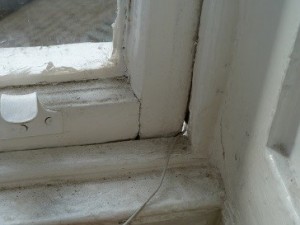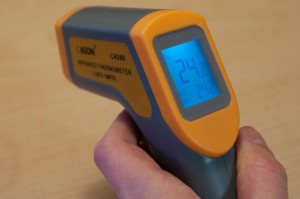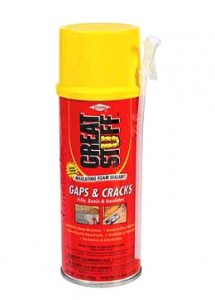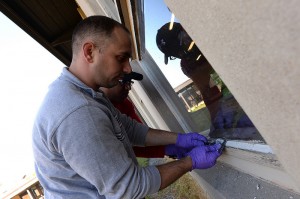 Air leaks can be costly to any property owner whose responsibility it is to pay the heating bill. So here are a few ideas to find them:
Air leaks can be costly to any property owner whose responsibility it is to pay the heating bill. So here are a few ideas to find them:
The hand test. When it’s cold outside, simply place your hand around the seals of doors and windows… as well as fireplaces, dropped ceilings, and any bathroom or kitchen fans to see if you can feel cold air seeping in. This same technique can be used to discover if your electrical outlets are serving as an entrance for chilly air flow.
 Invest in a thermal leak detector. This infrared thermometer can easily identify where air flow, either cold or hot, is trickling in. It detects wall surface temps and shows you hot or cold energy leak spots. This handy instrument won’t break the bank either… you can grab one by Black and Decker for under $30.
Invest in a thermal leak detector. This infrared thermometer can easily identify where air flow, either cold or hot, is trickling in. It detects wall surface temps and shows you hot or cold energy leak spots. This handy instrument won’t break the bank either… you can grab one by Black and Decker for under $30.
Light a candle. Light a tapered candle and hold it around areas you think are susceptible to air leaks: light fixtures, baseboards, crown molding, electrical outlets, air registers, attic accesses, hallway fans, etc. Be sure to turn off your furnace prior to conducting this test. Simply place the candle near where you believe there is a leak, if the flame flickers slightly, you have a small leak.
Go pro. If you don’t want to do it yourself or think you might miss crucial leaks, simply hire a contractor to conduct a blower door test. They’ll seal your entrance with a blower fan that depressurizes your home by sucking out all of the air, making it easier for them to detect both big and small leaks.
So now that you’ve found the leaks, what are the best ways to plug them?
For electrical outlets, install foam gaskets behind the cover plate. This is a very inexpensive way to cut down on cold drafts that sneak in through switch plates. You can easily insulate all outlets in a house for under $10.
 For cracks and crevices, a low-expansion spray foam like Great Stuff can fill in and cut down on the cold air. And for larger gaps or holes, a foam sealant such as Big Gap Filler will halt cold leaks in their tracks.
For cracks and crevices, a low-expansion spray foam like Great Stuff can fill in and cut down on the cold air. And for larger gaps or holes, a foam sealant such as Big Gap Filler will halt cold leaks in their tracks.
For leaky furnaces, fireplaces, or gas-fired hot water heaters, it’s important to use fire-resistant materials like sheet metal or furnace cement caulk. If a fireplace is no longer being used or is inoperable, cut a piece of rigid insulation foam board to fit up under the internal flue or build an easily removable DIY flue plug by stuffing fiberglass batting scraps into a trash bag and jamming it up into the flue. This will help cut down on drafts.
 Caulking or weather-stripping doors and windows can also keep the cold-air culprit at bay, saving you money each month on your heating bill. Another alternative is window and door insulation foam. Just one 12 oz. can of this spray foam can equal up to 22 tubes of caulk, making it a more-cost-effective treatment for windows and doors in multiple units.
Caulking or weather-stripping doors and windows can also keep the cold-air culprit at bay, saving you money each month on your heating bill. Another alternative is window and door insulation foam. Just one 12 oz. can of this spray foam can equal up to 22 tubes of caulk, making it a more-cost-effective treatment for windows and doors in multiple units.
I’ve personally used spray foam to fill leaks inside my home. It’s quick and easy with a relatively fast dry time. However, a word to the wise: no matter how you try to clean out the straw that delivers the foam from the can to the crack, you cannot reuse it at later time for another project. So make sure you get everything at once because a can is only good for a one-time application.
Photo credit: Magnus D / Foter.com / CC BY
Photo credit:jamesbastow/Foter/CC BY-SA
Photo credit: romainguy / Foter.com / CC BY-SA
Photo credit: U.S. Naval War College/Foter/CC BY
 Register for RMUC.25
Register for RMUC.25





